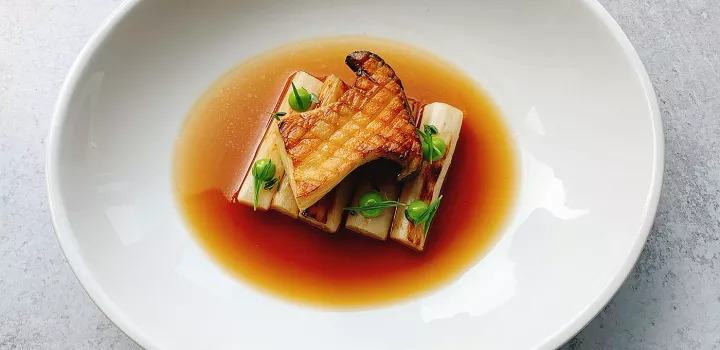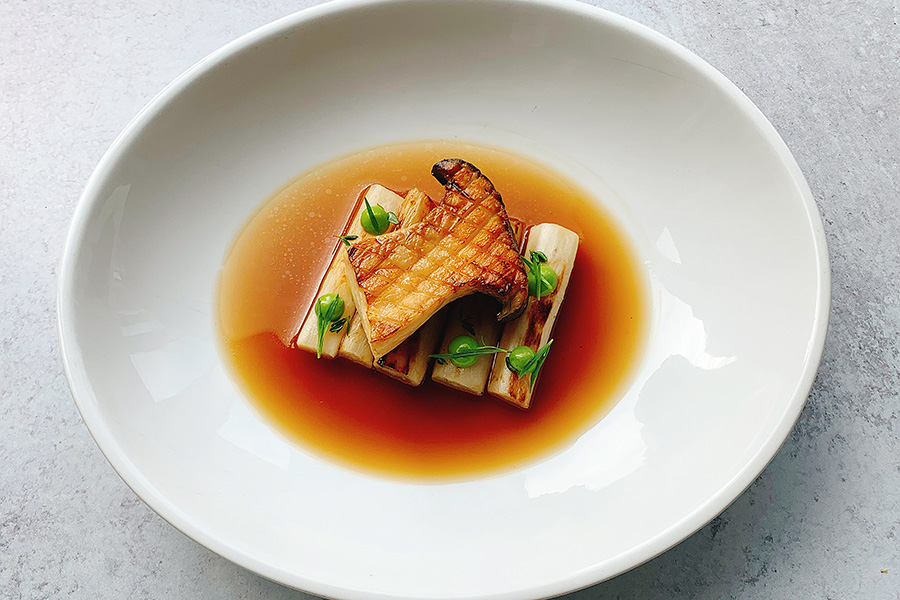
Finding Umami with a Fermented Mushroom Dish
Umami is the word on the tip of every serious culinary tongue. What is it and why is it so crucial to find and harness in our food?
The correlation between food and science has never been more evident. In modern times we are thinking critically, not just about what tastes good to us, but why it tastes good. We are learning that deep within our sensory receptors, our tongue, eyes, ears and nose are tuned to seek and relish certain aspects of a well-composed dish.
The word umami describes one of the five main tastes, alongside bitter, sweet, salty and sour. Over 100 years ago, Dr. Ikeda in Japan discovered Umami as an addition to the already documented four main tastes. Dr. Ikeda found that foods with high levels of glutamate, inosinate and guanylate (the three components of umami) have a distinct savoriness and depth of flavor.
Glutamic acid or “glutamate” is one of 20 amino acids, the building blocks of protein found in a large variety of meats, fish and vegetables. Inosinate is found in proteins such as meat and fish, and there are high proportions of guanylate in items such as dried mushrooms.
Umami’s impact increases when foods are processed by cooking, dehydration or fermentation. Many of our favorite delicious foods from around the globe are fermented. Now we understand why we enjoy them so much. Soy sauce, fermented soy beans, fish sauces, even Parmesan cheese reach high levels of glutamic acid through a lengthy fermentation process. The high levels of glutamate in these products are what our taste receptors recognize as the delicious umami taste.
Japanese culture uses a mixture of dried kombu (glutamate) with dried bonito (inosinate) to create an umami synergy, which is perceived in much higher levels than simply glutamate-rich products alone. In Western cooking, a mirepoix of carrots, onions and celery, which are glutamate-rich, are mixed with the inosinate-rich beef protein to form a delicious soup, broth or stew with flavor depth. In Chinese cooking, scallions, ginger, onions (glutamate) and chicken (inosinate) are combined for their synergistic effects and boost levels of glutamate perceived on the tongue.
A protein does not carry any taste. We can only perceive any kind of taste in our receptors once the proteins are broken down and the amino acid chain begins to break. Once this process happens, what we consider to be “free amino acids” form, and we are then able to perceive the umami taste. Aging a protein will cause the free glutamate levels to increase significantly. This is the same for cheese and the ripening process. Parmesan cheese, one of the most beloved fermented products, has extraordinary levels of free glutamate due to its lengthy fermentation and aging process.
When proteins are broken down, the taste receptors on our tongues allow us to perceive umami. A signal is sent from our taste receptors and stomachs triggering our brains to initiate the digestion of the protein.

I have been studying umami for some time now, experimenting with koji production and various forms of fermentation and building stocks using fermented products to boost levels of umami in my dishes. I recently began working on a recipe that would have a balance of the five main tastes with a strong baseline that we consider umami, sending messages to the brain to delve in for another spoonful.
I began by fermenting oyster mushrooms, which have a high level of glutamate. I prepared the mushrooms, initially dehydrating them and then rehydrating to remove any dangerous toxins, shredding them finely with a knife and combining them with aromatics of shallot, confit garlic and tarragon. The mixture is seasoned with a 2% kosher salt ratio which will aid in developing flavor while the mushrooms are fermenting. It is left to ferment for 72 hours until pungent. Then I cook the fermented mushrooms in a deep and rich chicken stock.
Meanwhile, I have added a significant ingredient for a rich and unique flavor: toasted barley. This warm, roasted flavor works beautifully with the fermented mushroom and chicken stock. After the barley is toasted it is added to the mushroom stock and left to infuse for several hours. The mixture is then strained and seasoned, balancing the rich flavors with brown rice vinegar for a touch of acidity.
Umami-rich salsify is cooked sous vide with aroma of thyme and olive oil and then charred over binchotan white charcoal. A large king oyster mushroom is brushed with clarified butter and coal-grilled, giving a boost of glutamate as the mushroom chars over high heat. I make a tarragon emulsion, which lends itself well to the flavors of the mushroom and barley, gives a pop of anise flavor, and of course, its beautiful green color contrasts the deep mahogany colors.
The dish is finished with some young tarragon leaves, a perfect combination for the coming months in a warming and comforting bowl, sure to rock your palate.

Recipe
Fermented Mushrooms, Toasted Barley Broth, Coal-Grilled King Oyster Mushroom, Salsify and Tarragon Emulsion
Fermented Mushrooms
Ingredients
- 500 grams oyster mushrooms dehydrated, rehydrated and shredded
- 2 banana shallots, peeled, finely sliced
- 4 cloves confit garlic
- 3 sprigs tarragon
- 2% salt
Directions
- Place shredded mushrooms, shallots, garlic confit and tarragon into a mixing bowl.
- Weigh the total of the ingredients.
- Measure 2% of the total weight in salt and add, mixing well.
- Place into a vacuum bag and seal on 100%.
- Leave to ferment at 70 F for 36-48 hours until pungent.
Toasted Barley Broth
Ingredients
- Fermented mushroom mixture
- 500 grams rich, quality chicken stock
- 1.5 grams Methycellulose F50
- 200 grams barley
- 40 grams brown rice vinegar
- Salt
Directions
- Place fermented mushroom mixture and chicken stock in a saucepan and heat gently for 25 minutes.
- Place barley grains on a sheet tray and bake at 340 F for 25 minutes until well toasted.
- Add toasted barley to broth, turn off heat and leave to infuse for 2 hours.
- Strain mixture.
- Add Methycellulose F50 and allow to hydrate.
- Heat on low heat until impurities rise to the surface.
- Strain broth through a fine, mesh sock.
- Add brown rice vinegar.
- Adjust seasoning if necessary.
Salsify
Ingredients
- 2 salsify stems, peeled
- 1 stem thyme leaves, picked
- Kosher salt
- Olive oil
- White Binchotan Charcoal
- Maldon sea salt
Directions
- Peel and cut salsify into 2.5-inch pieces.
- Place into a vacuum bag with olive oil, salt and thyme leaves.
- Using an immersion circulator, cook salsify for 2 hours at 84 C.
- Remove from bag and drain.
- Lightly grill salsify over coals until charred evenly.
- Re-season with Maldon sea salt.
Coal-Grilled King Oyster Mushroom
Ingredients
- 2 king oyster mushrooms
- Maldon sea salt
- Olive oil
Directions
- Cut mushrooms in half lengthwise.
- Score the cut side of the mushroom in a hatch pattern.
- Season well with Maldon salt and brush lightly with olive oil.
- Grill over Binchotan until crisp and cooked through.
Tarragon Emulsion
Ingredients
- 80 grams tarragon leaves
- 20 grams chervil leaves
- 20 grams parsley leaves
- 220 milliliter grapeseed oil
- 2 soft poached eggs
- Salt
- 1 lemon, juiced
Directions
- Blend herb leaves in a Vita-Prep with grapeseed oil until well combined.
- Pass through cheesecloth.
- Place into a piping bag and hang to separate excess water and remove any liquid from the oil.
- Place boiled eggs into a Vita-Prep and slowly add in herb oil to emulsify.
- Season well with salt.
- Add lemon juice.
- Pass mixture through a tamis.
- Place into a small squeeze bottle.
To assemble:
Ingredients
- Fermented mushroom and tasted barley broth
- Salsify
- King oyster mushroom
- Tarragon emulsion
- Young tarragon leaves
Directions
- Heat broth and pour into the base of a bowl.
- Place grilled salsify in the center.
- Pipe tarragon emulsion on top of salsify.
- Top each tarragon emulsion with young tarragon leaves.
- Place grilled king oyster mushroom in the center.
- Serve.
Explore umami with Chef Barry in ICE's Culinary Arts program.


Add new comment